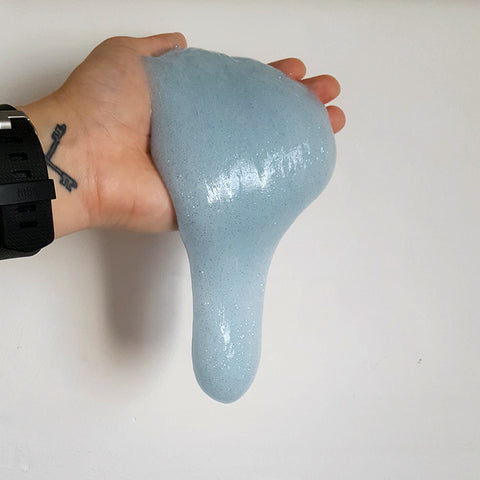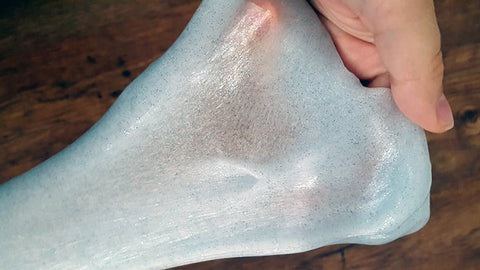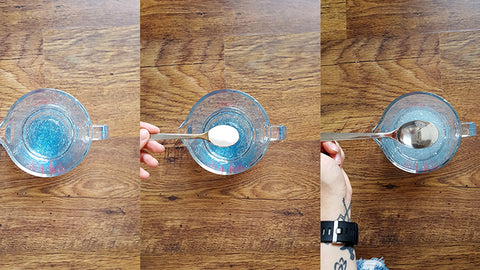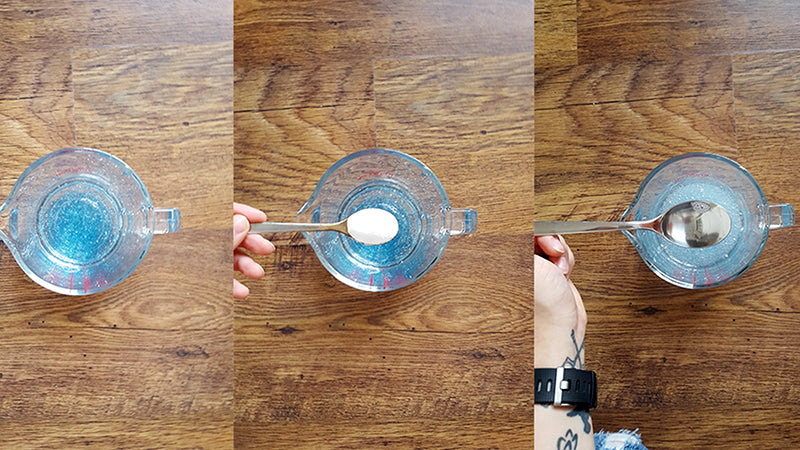Please be careful when using this on surfaces, for example varnished or painted wood. We advise keeping the slime on a surface like a chopping board.
Slime is obviously a big craze right now. I never really understood it, but then again when I was at school the big thing was braiding Scoobies (these were literally just plastic threads that you braided together to make different shapes). But it seems like slime is here to stay for the foreseeable future, you just can’t go wrong with a tub of ooze. Being curious I embarked on a mission to create the perfect slime, which now sits by my desk as a big squishy stress ball, and discover how it is made.
Slime is made after a chemical reaction between two main ingredients; polyvinyl alcohol and borate ion. Both of which you can find in everyday household items. Polyvinyl alcohol can be found in simple PVA glue and borate ion is created when bicarbonate of soda (baking soda) is mixed with contact lens solution. It’s super important to make sure that the solution you’re using contains the ingredients boric acid and sodium borate.
When I initially ventured out to source the ingredients for the perfect slime I made the mistake of buying the first contact lens solution I found without checking if it contained the key ingredients. The results of that batch of slime were dubious at best and disastrous at worst. One suggestion I found online to thicken my runny slime was to add dish soap and salt. Do not do this, all it results in is weird green slush that smells weird.
For my slime I created the borate ion by mixing the bicarbonate of soda (or baking soda) with the boric acid and sodium borate in the contact lens solution and when it comes in contact with the PVA glue the mixture gradually begins to thicken and turns into a viscous, gooey mass.

This is because when the polyvinyl alcohol is combined with borate ion they undergo a chemical reaction called an endothermic reaction. An endothermic reaction absorbs heat energy and we can see this at work when the slime goes cold! It also creates a non-newtonian fluid. The amazing thing about non-newtonian fluids is that they are neither a solid or a liquid, you can pick slime up like a solid but it will slide through your fingers like a liquid. Slime also does not have its own shape so it can change to fit whatever container it is in. Yet, because of its elasticity, it can be bounced like a ball. Using these examples you can demonstrate how the viscosity of non-newtonian fluids change and teach the properties of liquids and solids.

You can play around with the quantities of these ingredients, in particular, the contact lens solution, to create slimes with different viscosities. The more contact lens solution you add the thicker the slime becomes and vice versa, the less you add the oozier it becomes. I didn’t add enough contact lens solution to my initial batch of slime and found that it kept sticking to my fingers! Ask your students or kids which ingredient they think they would need to add more of to make their slime more like a liquid or solid.
You can even introduce this as an experiment into your science lesson by having them test out slightly different variations of the basic slime recipe below and record the results. Slime is great for discussing the properties of materials for this reason. Try it out by tugging it sharply which will cause the slime to break, yet if you gently pull it the slime will stretch out.

Below is the basic slime recipe, remember to lay down a protective mat or cloth to protect your surfaces! If you want to make your slime extra special you can always add glitter, sequins or glow in the dark paint. You can even add foaming shaving cream to make the slime go poofy and fluffy! To store keep it in an airtight container and you can keep it in the fridge to help prevent it from drying out.
The Perfect Slime Recipe
Ingredients
230ml (1 cup) of PVA glue
115ml (½ cup) of water
2 drops of your favourite food colour
1 tsp of bicarbonate of soda (baking soda)
1 tbsp of contact lens solution containing boric acid and sodium borate
Method
- To make the slime simply pour the PVA glue into a bowl and add the water, mixing until fully incorporated. To this mixture add your favourite food colouring, mixing until you reach your desired colour. At this point, you can also add any embellishments you desire, such as glitter or sequins!
- We then need to add the bicarbonate of soda to the mixture stirring thoroughly. At this point, the slime mixture should still be slightly runny.
- Now for the magic! Slowly add the contact lens solution and stir. You should feel the mixture thicken up quite quickly and when it starts coming away from the sides it’s time to get your hands in and knead the mixture. If your slime is still too sticky add a few more drops of saline solution until it firms up - be careful with this as adding too much will make the slime hard and brittle!

Ideas for other Scientific investigations? Let us know in the comments.

